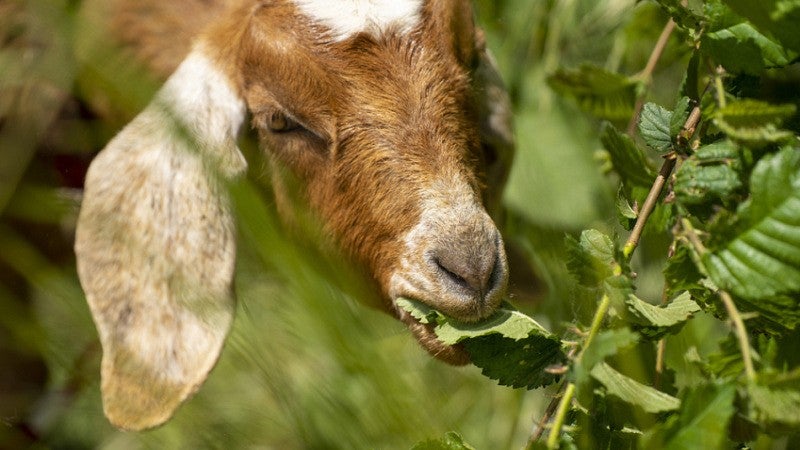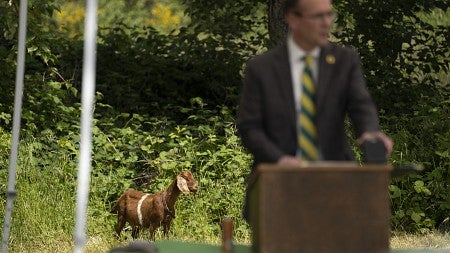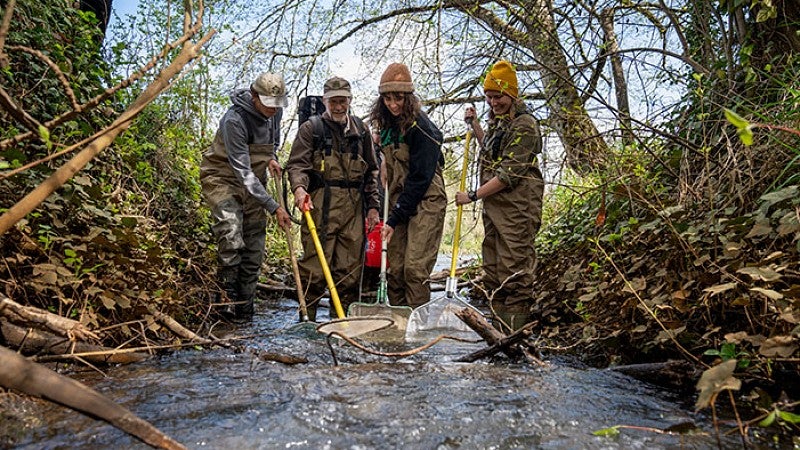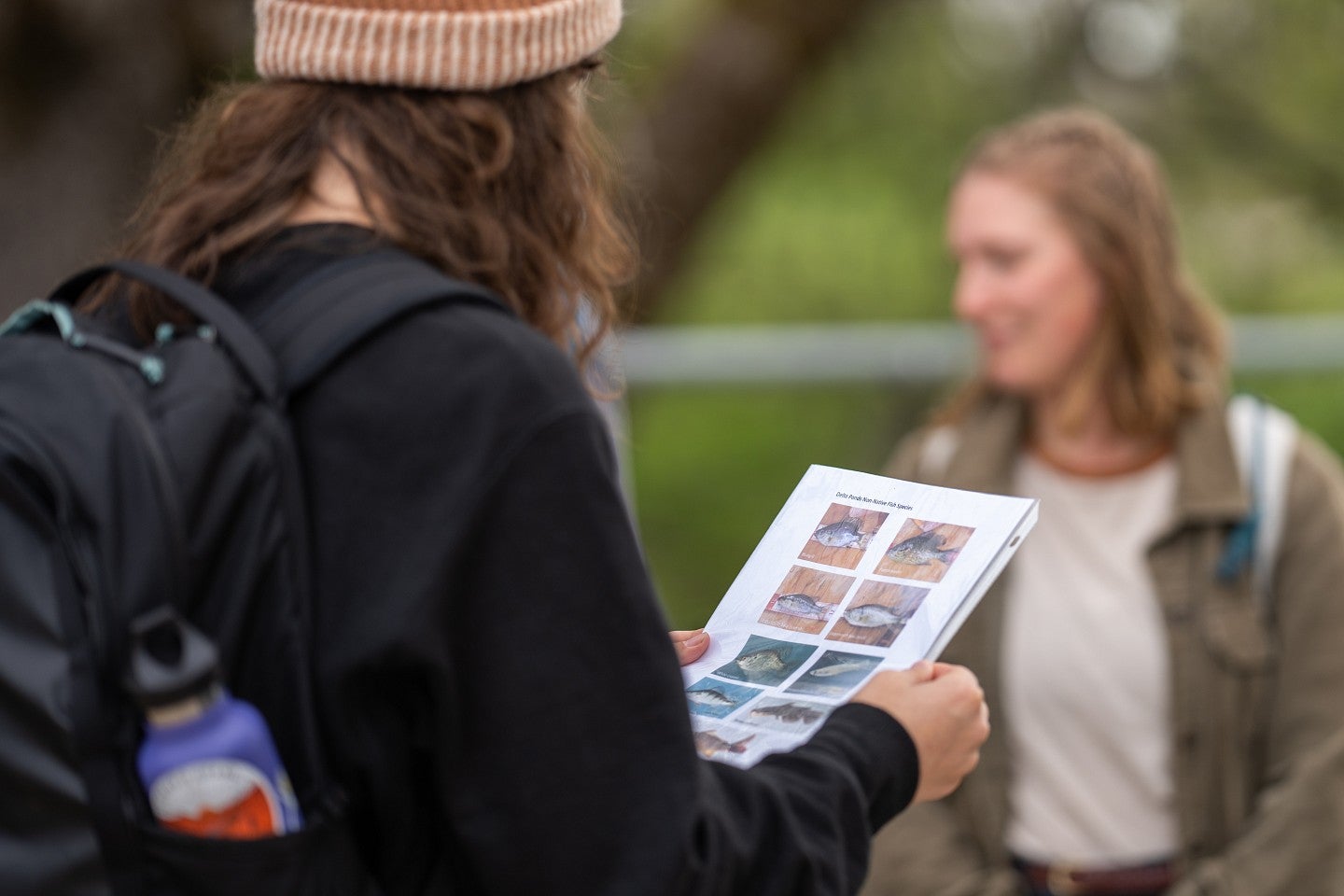
Goats on the Riverfront

In May 2022, the UO Society for Ecological Restoration (SER) Student Association partnered with the Office of Sustainability and Creekside Land Management on a project to include goats in a demonstration of restoration efforts at the WRNA.

Highlights include:
- Volunteers removed approximately nine invasive or toxic plant species.
- Volunteers actively conserved over eight native woody species.
- Volunteers removed over 30 pounds of litter.
- Ten goats grazed approximately 1/5 of an acre over a three-day period.
- Goats removed about 30 % of vegetation and 26% of blackberries within the designated treatment plots.
- The goats generated plenty of human interest throughout their time at the WRNA, as seen in Around the O and The Daily Emerald.
Willamette Valley Prairie Research and Restoration
An area within the WRNA is temporarily allocated to the Institute of Ecology and Evolution for Willamette Valley prairie restoration research. Under a National Science Foundation grant and in collaboration with UO faculty and students, Associate Professor Jeff Diez will create “restoration gardens” of native species common to the Willamette Valley prairie ecosystem. The research project will occur between August 2022 and August 2025.
- Contribute to the general understanding of the plant population and community ecology through tests of modern ecological theory.
- Use ecological research to inform prairie restoration and management.
- Educate graduate and undergraduate students in ecological theory and practice at the WRNA.
- Help develop the WRNA into an exceptional site for combined research, education, and student and public engagement.

Restoration of the WRNA’s grassland habitat is specified in the Desired Future Conditions (DFCs) identified in the WRNA Landscape Management Plan. DFCs provide a descriptive long-term vision for the condition of the site and its target habitats and species. The Willamette Valley prairie research project will improve the ecological integrity of the site over time, and the diverse collection of colorful plants and flowers will enhance visitors’ experience.
Millrace Outfall Fish Sampling

- Pacific Lamprey
- Western Brook Lamprey
- Largescale Sucker
- Northern Pikeminnow
- Speckled Dace
- Redside Shiner
- Three-spine Stickleback
- Green Sunfish
- Pumpkinseed

Fuller Initiative Land Lab
The Fuller Initiative Land Lab (FILL) is an area within the WRNA temporarily allocated to the Department of Landscape Architecture. FILL is an innovation landscape designed to support outdoor learning in the WRNA. UO students and faculty utilize the Land Lab to perform trans-disciplinary research and field experiments. The site also provides exceptional opportunities for applied education in urban ecology.
The Fuller Initiative Land Lab’s goals include:
- Educating students in urban ecology through survey, land care, planting, and interpretation.
- Regenerating the WRNA through the establishment of test plots, meadows, and gardens.
- Activating the UO North Campus riverfront with temporary art exhibitions, wildflower displays, and community events.
- Creating an outdoor space for trans-disciplinary research on the Environment Initiative and supporting this research with Environmental “Design Thinking.”
- Displaying research for mixed-reality, game-based interpretation that is accessible regardless of English fluency.
During the Oregon 22 World Athletics Championships, the Fuller Initiative partnered with Travel Oregon and the Center for Applied Second Language Studies to build seven landscape installations representing the seven regions of Oregon. These installations offered a mixed-reality game-based interpretation strategy. This strategy prioritized accessibility for all visitors, regardless of English language fluency.
See regional news coverage of ongoing research and projects at the Oregonian and University of Oregon.
Fuller Lab - Scholarship and Awards
Scholarship
- Geffel, Michael, et al. “Viridic Disturbance: Reprogramming the Tools of Landscape Maintenance.” LA+ Green 15, 2022.
- Geffel, Michael. “Landscape Design through Maintenance: Field Case Studies in Parametric Mowing.” Landscape Journal 39(2), 2021.
- Geffel, Michael. “Terrestrial Practices: Pulling Landscape Back to Earth.” Kerb 28, 2020.
- Geffel, Michael. “Lawnmower Man.” Zach Mortice, author. Landscape Architecture Magazine, 2019.
Awards
- 2024 Pacific Horticulture Design Futurist Top Prize, 'Fuller Initiative Land Lab.'
- 2023 Oregon Society of Landscape Architects Honor Awar, Pro-Bono Design, 'Oregon Experience Laboratory.'
- 2023 Oregon Society of Landscape Architects Green Ribbon, Climate Action, 'Oregon Experience Laboratory.'
